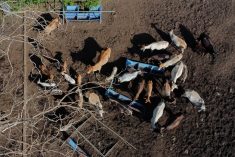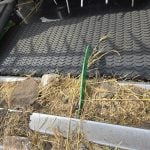Aster yellows is a pretty name for a serious disease of herb and spice crops.
In the 1999 growing season, it was also found at higher levels in canola crops.
So named because it was first discovered on asters and because it turns the leaves of some plants a brilliant yellow, the disease is caused by a viral-like pathogen that is transmitted by leafhoppers.
Although aster yellows can overwinter in biennial or perennial crops and weeds such as dandelion, plantain and quackgrass, most infections are caused by leafhoppers migrating from the United States.
Read Also

China’s grain imports have slumped big-time
China purchased just over 20 million tonnes of wheat, corn, barley and sorghum last year, that is well below the 60 million tonnes purchased in 2021-22.
There are no fungicides for its control, said Penny Pearse, plant disease specialist with Saskatchewan Agriculture. There are no insecticides registered for control of leafhoppers in canola, and no effective organic controls are yet available for herbs and spices.
“Management of aster yellows in canola is not normally an issue because disease incidences are low and do not result in significant loss to quality or yield. This year’s infestation was due to the right combination of environmental conditions, crop maturity and leafhopper populations,” said Pearse.
Looking for answers
Agriculture Canada’s Saskatoon research centre, in collaboration with the Saskatchewan Herb and Spice Association, is studying aster yellows in herb and spice crops with funding from the Canada-Saskatchewan Agri-Food Innovation Fund.
In the spring of 1999, plots were established at Aberdeen, Dundurn, Moose Jaw and Prince Albert. Echinacea, caraway, feverfew, coriander and valerian, all of which are susceptible to aster yellows, were planted.
Suction traps at the plots pull in air and insects to monitor arrival of the leafhoppers, while sticky cards monitor the species and density within the plots.
“We also receive daily reports from Environment Canada about wind trajectories during the growing season,” said Owen Olfert, an Agriculture Canada research scientist in Saskatoon.
“Our counts from the suction traps and sticky cards indicated that the leafhoppers arrived early this year, showing up in Moose Jaw first and Prince Albert last, and it’s the early migrations – early May – that can cause the worst damage. So the timing of the winds is important.”
Also, leafhoppers survived recent mild winters, leading to heavy infestations.
The researchers also studied the efficacy of three organic insecticides but, perhaps because of this year’s frequent rains, “they weren’t an overwhelming success,” said Olfert. Different organic products may be tried next year.
Management of aster yellows in herbs and spices is limited to the following: Remove and destroy infected plants; apply insecticides to surrounding weeds to control leafhoppers; and, when dividing crowns and roots, select healthy plants for vegetative propagation.
The options for control of aster yellows in canola are also limited. Pearse said early-seeded spring crops or fall-seeded crops are less susceptible, but rotation doesn’t offer much relief because many crops can be infected with aster yellows. Control perennial weeds within and around crops and avoid planting canola near crops of perennial forages or echinacea known to have aster yellows.














